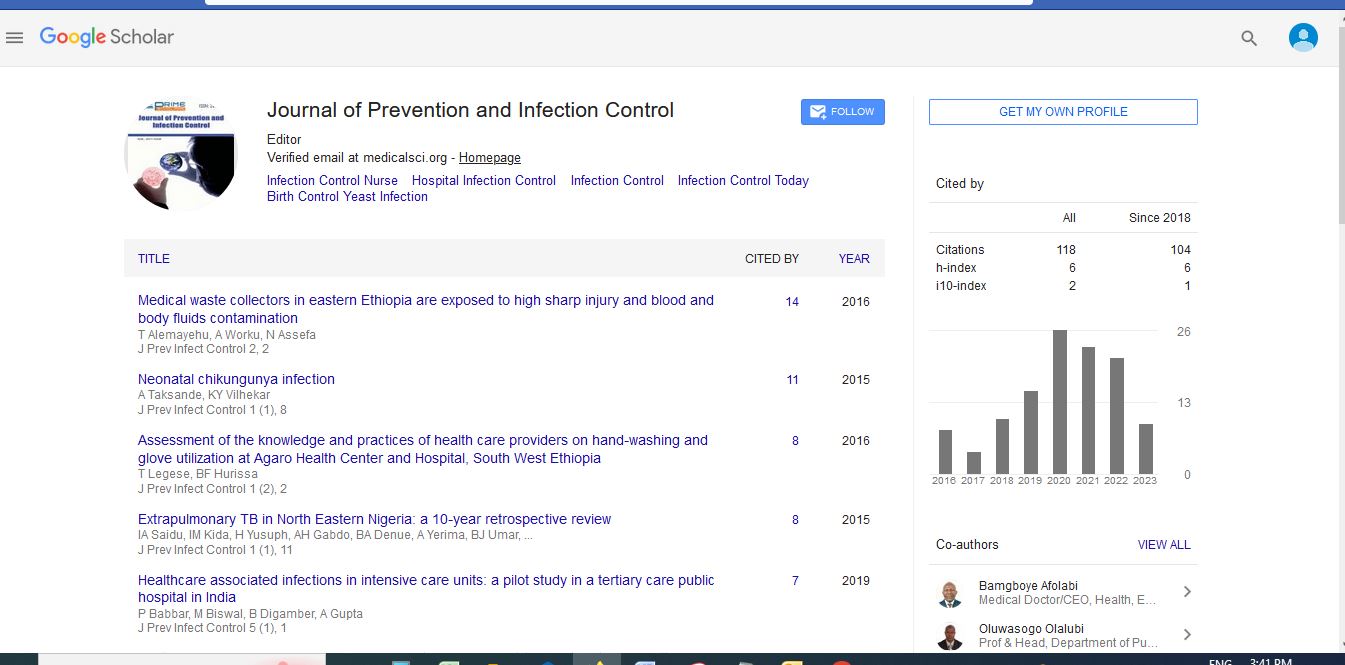Opinion - (2024) Volume 10, Issue 4
Sterilization: Techniques, Applications, and Future Innovations
Tao Jiang*
Department of Infection Prevention and Control, Chinese University of Hong Kong, China
*Correspondence:
Tao Jiang,
Department of Infection Prevention and Control, Chinese University of Hong Kong,
China,
Email:
Received: 02-Dec-2024, Manuscript No. IPJPIC-25-22457 ;
Editor assigned: 04-Oct-2024, Pre QC No. IPJPIC-25-22457 (PQ);
Reviewed: 18-Dec-2024, QC No. IPJPIC-25-22457 ;
Revised: 23-Dec-2024, Manuscript No. IPJPIC-25-22457 (R);
Published:
30-Dec-2024, DOI: 10.36648/2471-9668-10.4.34
Introduction
Sterilization is a critical process in infection control, ensuring
that harmful microorganisms, including bacteria, viruses, fungi,
and spores, are effectively eliminated from medical instruments,
laboratory equipment, and other materials. It plays a crucial role
in healthcare, pharmaceuticals, food processing, and various
industries where hygiene and safety are paramount. This article
provides an in-depth exploration of sterilization, including its
methods, significance, and best practices. Sterilization is essential
in preventing infections and maintaining a safe environment,
particularly in healthcare settings. The lack of proper sterilization
can lead to the spread of infections, posing severe health risks to
patients and healthcare professionals. Some of the key reasons
for sterilization includes Preventing Hospital-Acquired Infections
(HAIs) these infections are caused by non-sterile medical
equipment and can lead to severe complications. Ensuring
Patient Safety sterile surgical instruments minimize the risk of
postoperative infections. Maintaining Laboratory Integrity proper
sterilization of equipment ensures the accuracy of research and
medical diagnostics. Controlling Disease Outbreaks effective
sterilization helps prevent the spread of infectious diseases in
healthcare and community settings. Enhancing Product Safety
sterilization in pharmaceutical and food industries ensures that
products are free from harmful contaminants. Sterilization can
be achieved through various physical, chemical, and mechanical
methods. The choice of method depends on the type of material,
the level of sterilization required, and the specific industryâ??s
regulations.
Description
Heat is one of the most effective sterilization methods, used
widely in medical and industrial applications. It is categorized into
Moist Heat Sterilization (Autoclaving) Uses pressurized steam at
high temperatures to kill microorganisms. It is highly effective
for sterilizing surgical instruments, laboratory glassware, and
medical waste. Dry Heat Sterilization Involves heating objects at
high temperatures for extended periods. It is ideal for materials
that cannot tolerate moisture, such as powders, oils, and metal
instruments. Chemical sterilization uses antimicrobial agents to
destroy microorganisms. Common methods includes Ethylene
Oxide (EtO) Gas Sterilization effective for heat-sensitive medical
devices, but requires careful handling due to its toxic and
flammable nature. Hydrogen Peroxide Plasma Sterilization uses
ionized hydrogen peroxide gas to eliminate microorganisms,
making it an environmentally friendly alternative. Peracetic
Acid Sterilization a strong oxidizing agent used for sterilizing
endoscopes and surgical instruments. Radiation is used to sterilize
medical supplies, pharmaceuticals, and food products. The two
main types are employs high-energy gamma rays to break down
microbial DNA, making it ideal for disposable medical products.
Uses high-energy electrons for rapid sterilization, commonly
applied in medical and food industries.
Conclusion
Air Filtration in Clean Rooms HEPA (High-Efficiency Particulate
Air) filters remove bacteria and viruses from air systems
in hospitals and laboratories. Several factors influence the
success of sterilization, including microbial load the number
of microorganisms present before sterilization affects the
required sterilization time and method. Material type Heatsensitive
materials require alternative sterilization methods
such as chemical or radiation sterilization. Temperature and
Exposure Time higher temperatures and prolonged exposure
increase the effectiveness of sterilization. Presence of Organic
Matter blood, tissue, and other organic materials can interfere
with the sterilization process. Sterilizer Maintenance regular
maintenance and validation of sterilization equipment ensure
consistent performance.
Acknowledgement
None.
Conflict Of Interest
The author declares there is no conflict of interest.
Citation: Jiang T (2024) Sterilization: Techniques, Applications, and Future Innovations. J Prevent Infect Control. 10:34.
Copyright: © 2024 Jiang T. This is an open-access article distributed under the terms of the Creative Commons Attribution License, which permits unrestricted use, distribution, and reproduction in any medium, provided the original author and sourceare credited.

